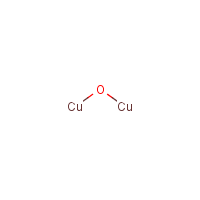Copper(I) oxide
Agent Name
Copper(I) oxide
Alternative Name
Cuprous oxide
CAS Number
1317-39-1
Formula
Cu2-O
Major Category
Metals

Synonyms
Brown copper oxide; C.I. 77402; CI 77402; CP Cuprous Oxide Pigment Grade; Caocobre; Cobre [Sandoz]; Copox; Copper Sandoz; Copper hemioxide; Copper nordox; Copper oxide (Cu2O); Copper oxide, red; Copper protoxide; Copper sardez; Copper suboxide; Copper(1+) oxide; Copper-sandoz; Cupper oxide [Russian]; Cupramar; Cuprocide; Cuprous Oxide Type Two; Cuprous Oxide, AA Grade; Cuprous oxide [ISO]; Dicopper monoxide; Dicopper oxide; Fungi-rhap Cu-75; Fungimar; Kupferoxydul [German]; Kuprite; Nordox; Oleo nordox; Oleocuivre; Oxyde cuivreux [French]; Oxyde cuivreux [ISO-French]; Perecot; Perenex; Perenox; Purple Copp 92; Purple Copp 97; Purple Copp 97N; Red Copp 92; Red Copp 97; Red Copp 97N; Red copper oxide; Yellow compound; Yellow cuprocide; [ChemIDplus] Kupfer-(I)-oxid; Dikupfermonoxid; [IUCLID] UN3077
Category
Metals, Inorganic Compounds
Description
Yellow, red, or brown solid; Practically insoluble in water; [Merck Index] Dark red powder; [Sigma-Aldrich MSDS]
Sources/Uses
Used mainly in marine paints to inhibit barnacles and algae; Also used as a seed and crop fungicide, a ceramic and glass pigment, a catalyst, a carbon monoxide absorbent, in brazing pastes, and in rectifiers; Occurs in nature as cuprite; [Ullmann] Also used in batteries, electroplating, and welding fluxes; [Hawley] Other uses include photoelectronics, hydrometallurgy , as an antiseptic for fishnets, antioxidant in lubricants, reducing agent in synthesis, and in the purification of helium; [EPA/OHMTADS]
Comments
An eye and respiratory tract irritant; Can cause metal fume fever after inhalation and injury to the liver and kidneys after ingestion; [ICSC] Copper-induced metal fume fever is not as common as zinc-induced because of the higher temperature required to produce copper oxide. (Zn mp = 419.5; Cu mp = 1083 deg C.) Acute copper poisoning after ingestion can cause liver injury, methemoglobinemia, and hemolytic anemia. Acute renal failure may result, secondary to massive hemoglobinuria. [Goldfrank, p. 1259] Slowly oxidized by moist air to cupric oxide; [Merck Index] An eye irritant; Toxic by ingestion; [Sigma-Aldrich MSDS] See "Copper."
Biomedical References
Exposure Assessment
TLV (ACGIH)
1 mg/m3, as Cu
PEL (OSHA)
1 mg/m3, as Cu
MAK
0.01 mg/m3, respirable fraction (Cu, inorganic cmpnds)
IDLH (NIOSH)
100 mg/m3, as Cu
Lethal Concentration
LC50 (rat) = 50,000 mg/m3/4hr
Explanatory Notes
mp = 1,230 deg C; [Sigma-Aldrich MSDS] The Guide in the Emergency Response Guidebook is for "Environmentally hazardous substances, solid, n.o.s."
Adverse Effects
Anemia
Hemolytic anemia
Methemoglobinemia
MetHgb is secondary toxic effect
Hepatotoxin
Hepatoxic (a) from occupational exposure (secondary effect) or (b) in animal studies or in humans after ingestion
Nephrotoxin
Yes
Diseases, Processes, and Activities Linked to This Agent
Processes
Industrial Processes with risk of exposure:
Activities
Activities with risk of exposure: